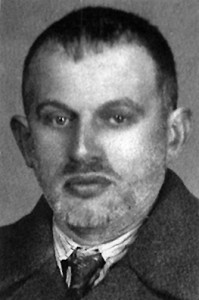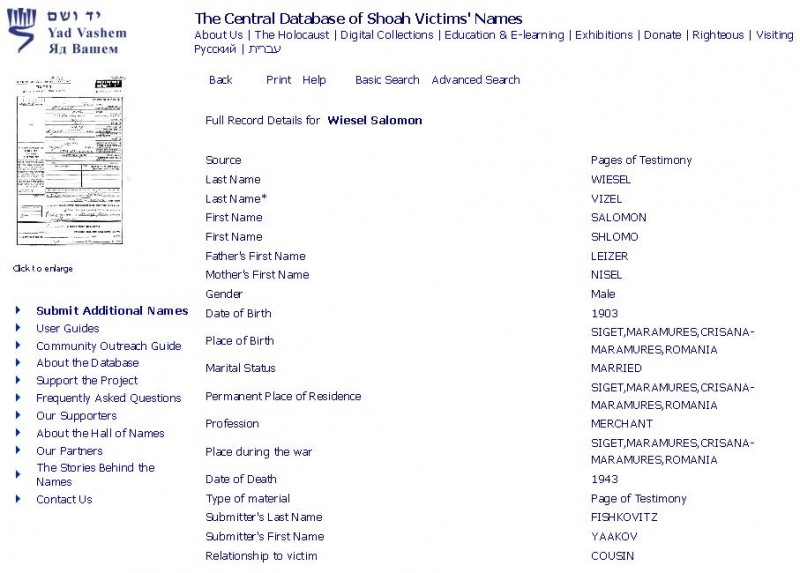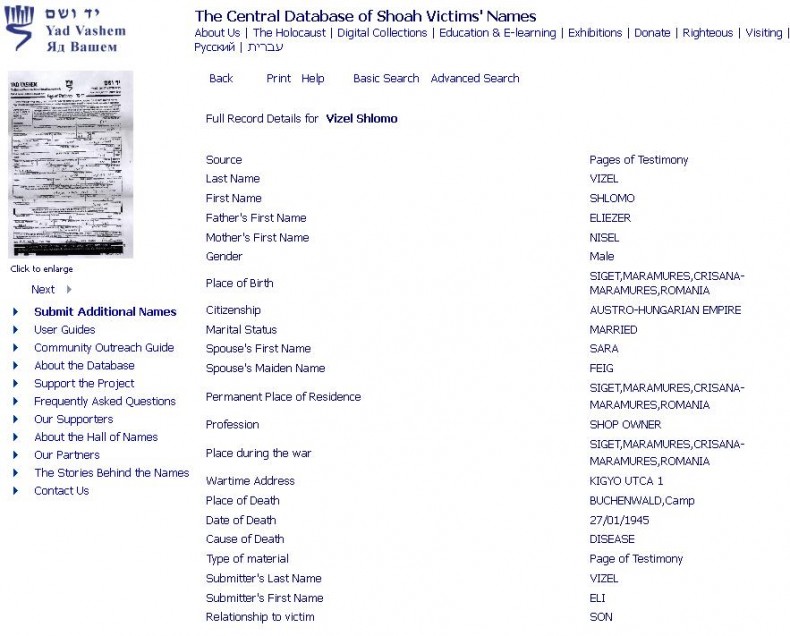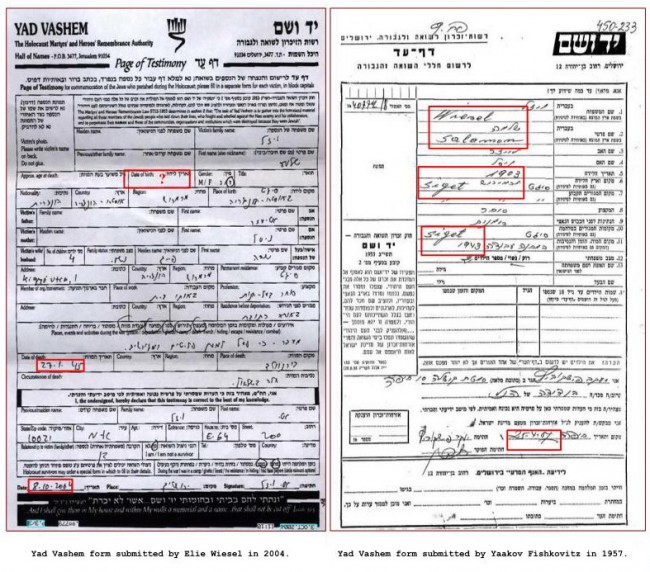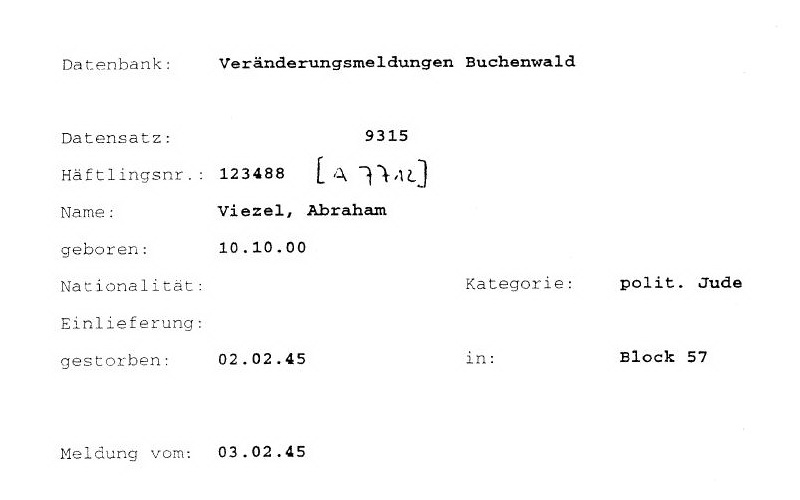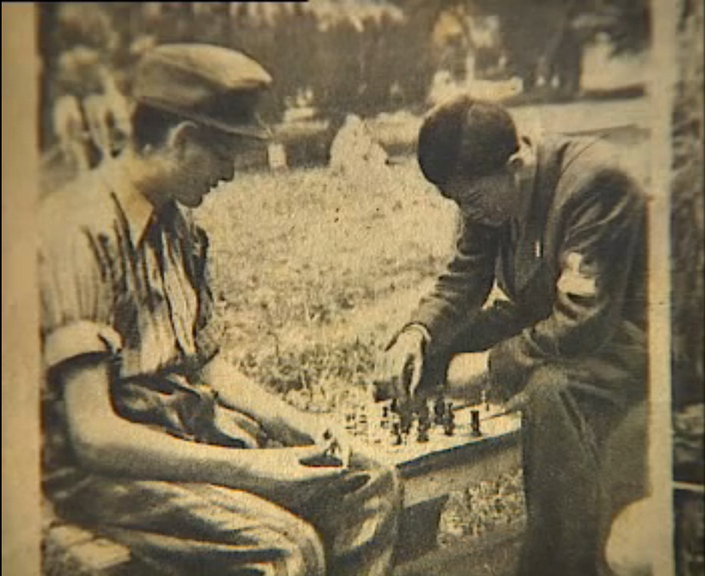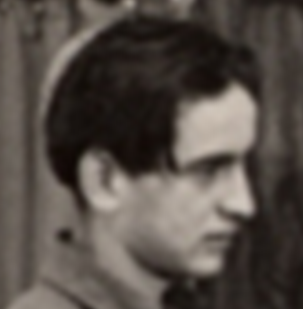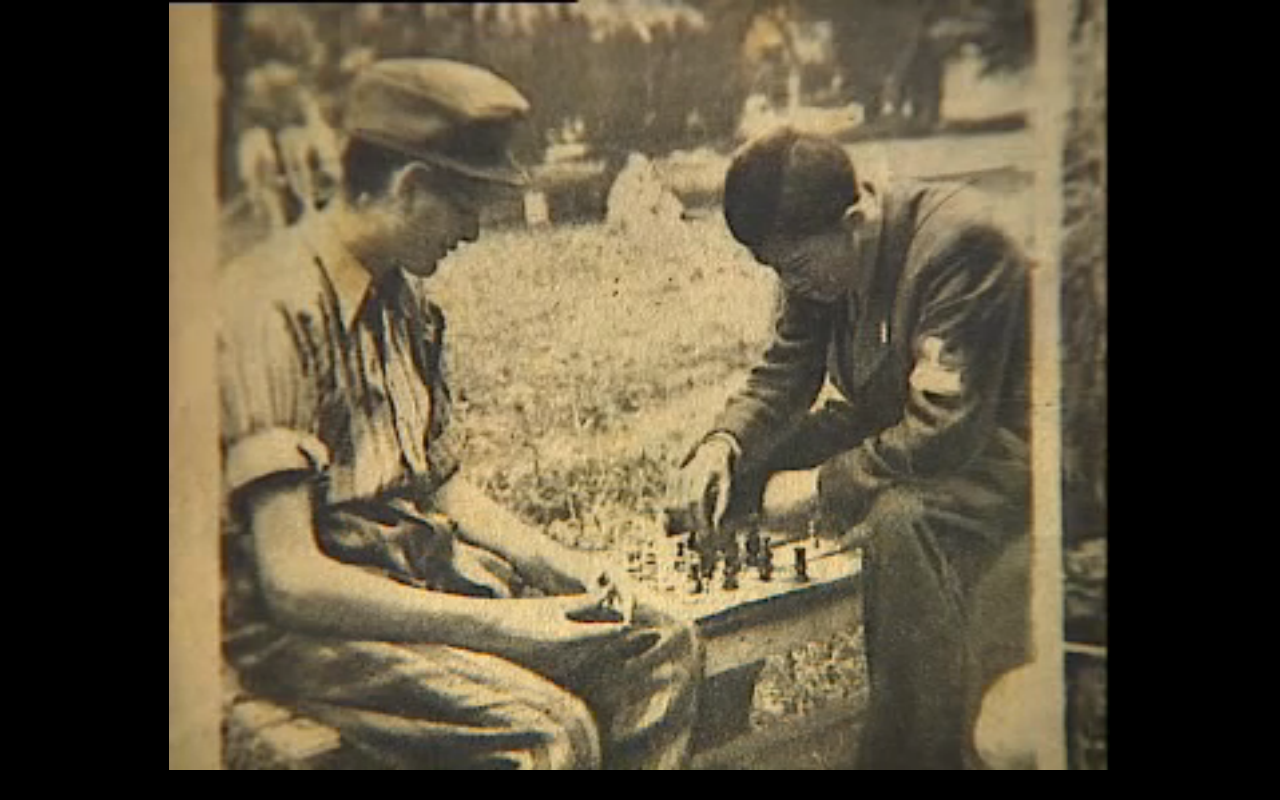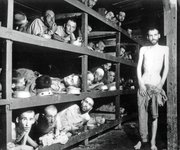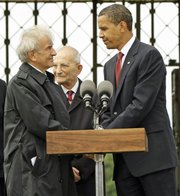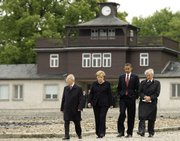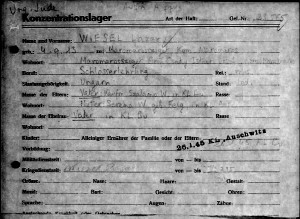Blog
Relative of Shlomo Wiesel says he died in 1943, not at Buchenwald
Written on October 16, 2011 at 6:32 pm, by Carolyn
By Carolyn Yeager
Elie Wiesel’s father Shlomo in 1942, according to Hilda Wiesel.
Is he 39 or 48 years old?
A report in the Yad Vashem Shoah Victims database by Yaakov Fishkovitz contradicts Elie Wiesel’s story about his father’s death.
Yaakov (Jacob) Fishkowitz filled out a death form in 1957 for his cousin Shlomo Wiesel, shortly after Yad Vashem first began its “Central Database of Shoah Victims Names.”1 He also filled out a form for Shlomo’s mother Nisel Basch Wiesel, his aunt. The cousins shared a maternal grandfather, Moshe Basch.
Yaakov was the son of Mentza Basch, daughter of Moshe, and Fishel Fishkovitz. Yaakov recorded Shlomo’s date of birth as 1903, which is much later than has been assumed, making Elie Wiesel’s father only 40 years old when he died! However, since Wiesel himself was 14 or 15 years old in 1943 this makes a lot more sense for an Orthodox Hasidic father-son. I will examine this further on in this article.
As seen in the two Yad Vashem Shoah Victim reports below—one by Fishkovitz and the other by Elie Wiesel—Yaakov spells the last name as both Wiesel (German) and Vizel (Roumanian). The German ‘W’ is pronounced as the English ‘V;’ similarly with s and z. He also gives both the formal name Salomon and its casual form Shlomo. Elie, on the other hand, spells his father’s name as Vizel and his own name as Eli Vizel, dropping the ‘e’ in his first name that he adopted for his post-war identity.
Shlomo’s children have never or seldom used the formal ‘Salomon’ for their father, but they do agree that Eleizer (or Leizer) and Nisel were his parents and that he was born in Sighet; that he was married and operated a store. Yaakov uses the word “merchant” while Elie uses “shop owner.” Elie adds his mother’s name, Sara Feig, but leaves his father’s date of birth blank, while also giving an incorrect date for his death according to his own book, Night.
The details from the forms (the form itself is shown in upper left corner), are translated into English from the Yiddish that was used by Elie and partially by Yaakov to fill out the forms. However, the dates can be read. The first one is by cousin Fishkovitz in 1957; the second one by son Elie in 2004, almost 50 years later.
(Click on forms to see a larger, full image.) Notice that each submitter fills in what he knows or believes to be important. Yaakov knew the year of his cousin’s birth; it may have been close to his own. Elie did not know, or doesn’t want us to know. He has never written it or given that information to an interviewer. This is important, but even more important is that Yaakov says Shlomo died in 1943 in Sighet*, the year before the deportation of the Jews of Sighet! This changes the entire narrative. [*Correction was made in a later article: it actually says Shlomo lived in Sighet during the war; he died in a labor camp in 1943.]
What evidence do we have for Shlomo’s age?
In Elie Wiesel’s Night (“a true story, every word is true”) Eliezer’s father answers “fifty” when asked his age by a friendly Jew when they first arrive at Auschwitz in May 1944. Eliezer answers that he is fifteen years old. The Jew tells them to lower and raise their ages respectively, which they do. (Even so, they’re put in a line that takes them right up to the edge of a pit of fire before they are turned away.) Because of this, Shlomo Wiesel has generally been assumed to have been born in 1894, although that has never been verified. For example, Wikipedia does not give a date.
In Hilda Wiesel’s Shoah Foundation testimony, she shows the photo of her father that is at the top of this article, and says it was taken in 1942. Does he look like he is 39 in this photo (born in 1903) or does he look to be 48 (because he was 50 in 1944)? It’s impossible to tell for sure, but he looks like a youngish man to me.
As we know, there are no records at Auschwitz-Birkenau or Buchenwald for a Shlomo Wiesel that fits his profile. Nor are there any for Elie Wiesel and his profile. The records that are used by the “Wiesel-in-Buchenwald” supporters are those for Abraham Viezel (also spelled Vizel or Wiesel), born Oct. 10, 1900 in Sighet, who died at Buchenwald on Feb 2, 1945. He died in Block 57; the death report was made out on Feb. 3, the following day. Yet Elie Wiesel claims in Night and elsewhere his father died on Jan. 28 and was carted off to the cremation ovens immediately, fully 5 days before Abraham’s death took place.
Death record for Abraham Viesel at Buchenwald, brother of Lazar Wiesel whose Auschwitz # was A7713
This Abraham Viesel is the same Abram Wiesel who was the older brother of Lazar Wiesel, according to Myklos Gruener, who says the two brothers had become his comrades at Auschwitz-Birkenau after the death of his father. (Auschwitz records exist for Myklos, his father and two brothers, as well as for Lazar and Abram Wiesel, including each of their numbers.) Abram’s Auschwitz tattoo number A7712 is written by hand on this death record, as well as his Buchenwald number, 123488.
If Shlomo died in 1943, this would explain why there is no death record for him at Buchenwald. Are there any other convincing reasons to go along with the 1943 date? Yes. In Night and in All Rivers Run to the Sea, we’re told of Shlomo’s resistance work helping Jews with legal problems and those who needed to flee from one place to another. He had been jailed for it, something mentioned by both Elie and Hilda. Elie characterized his father’s tireless efforts as “out of a loving, helpful heart.” But was his father, and his family, more radical than we’ve been led to believe? Was Shlomo’s life a dangerous one? Were there disputes about money—money collected to buy weapons, or for passage to safe places? Or perhaps there was anger within the Jewish community over who was being helped and who wasn’t?
In All Rivers, on page 4, Wiesel writes that as a child and adolescent he “saw his father rarely […] The Sabbath was the only day I spent with him.” “Often preoccupied,” his father spent the week in his little grocery store and at the “community offices where he worked to assist prisoners and refugees threatened with expulsion.” Expulsion from where? By whom? What were the community offices? Wiesel names Sighet as a “sanctuary for Jews fleeing …since 1640.”
What knowledge can we piece together about Shlomo?
Shlomo was a preoccupied man. He ran a store. He took in deliveries. He may have been involved in smuggling – guns, people, documents. Smuggling was a way of life among the Zionists. Jews began going to Palestine long before Elie Wiesel was born. There were different factions of Jews—the Haganah was formed in 1920 to guard Jewish settlers in Palestine. In 1931 the Irgun splintered off and there was sometimes bitter enmity between the two organizations all the way up to 1948. The Irgun policy was that every Jew had a right to enter Palestine and it became the major smuggling arm for the Zionists. The Irgun worked in Poland, for example, in the 30’s to bring Jews into Palestine with the cooperation of secret agencies of the Polish government. (See “The Role of the Irgun in Central and Eastern Europe” at http://www.eliewieseltattoo.com/elie-wiesel-and-the-mossad-part-ii)
It is fully possible that as things heated up in 1943, Shlomo got caught in some crossfire — perhaps was killed by the Hungarian police. If this were the case, Elie, as only son, may have been sent to France for safety before the deportations of Spring 1944. Further, if this were the case (a story as good as any other), Elie was an Irgun-supporting Zionist from an early age, which fits everything we know about him.
On page 8 of Night, Wiesel wrote:
In those days [Spring 1944] it was still possible to buy emigration certificates to Palestine. I had asked my father to sell everything, to liquidate everthing, and to leave. ‘I am too old, my son,’ he answered. ‘Too old to start a new life. Too old to start from scratch in some distant land …’
If he were only 40, that is not credible. Even at 50 he was not too old, unless he really didn’t believe the worst would happen and that things would right themselves. His children were certainly not too old and he would have them to look after him in his old age. Something doesn’t add up here. This “good man” doesn’t protect his family because he feels too tired at age 40-50 to go somewhere new? He allows them all to be taken prisoner because he can’t see what’s coming, even though he’s spent his adult life helping Jewish prisoners and refugees? Wiesel often fails to give convincing explanations for why events happen as they do in his writings. I have noticed it again and again, and commented on it. It seems to me to be a combination of laziness and lack of true inventiveness. He has admitted that he was rather spoiled and lazy in his childhood and youth; one doesn’t see any evidence of change.
The age of the typical Hasidic bride and groom
Back to the question of the appropriateness of Sholmo Wiesel being age 40 in 1943-44. The Hasidic sect sees the ideal age of marriage for a male as 18-21. They encourage the bride and groom to be close in age. Taken from the New York Times article on an important Hasidic wedding:
What they saw was a marital merger of two leading international Hasidic dynasties, the Bobovers of the Borough Park neighborhood in Brooklyn and the Satmars of Williamsburg. The 19-year-old groom is a grandson of the Bobover Grand Rabbi, Shlomo Halberstam. The 18-year-old bride is a granddaughter of the Satmar Grand Rabbi, Moses Teitelbaum. The two grand rabbis are the descendants of the first Hasidic leaders in Europe. They are also first cousins and close friends.2
Another Hasidic wedding is announced, this one in Israel.
Even longtime Hassidim are raising their eyebrows: A 16-year-old young man is engaged to his 15-year-old second cousin, both great grandchildren from “Hassidei Vizhnitz.” Thousands of members of the Vizhnitz Hassidic sect, one of the largest and wealthiest in the world, are expected to attend the festive wedding ceremony, which will take place in approximately another year.3
If Shlomo were born in 1903, as Yaakov Fishkowitz has it, he would have been 25 years old in September 1928 when his third child and first son Eliezer was born. His first child Hilda was born in August 1922, when he would have been 19 years old. Perfect for a Hasidic man!
On the other hand, if he were born in 1894, he was already 34 when Elie was born, and 28 when he had his first child. That is too old and is not in the tradition of his community! That may be why Wiesel avoids mentioning his father’s date of birth; it does not fit the story of Night, which he adopted as his own. Here’s a thought: Is there an Hasidic law or tradition that forbids lying about one’s parents and other ancestors? Probably, which can be the reason he says so little about his father, mother and grandparents as far as checkable data goes.
Is it not strange for the ‘High Priest of Memory’ to be so negligent in recording the history of his family? He only filled out the Yad Vashem form (with a camera aimed at him) at the behest of that institution, as an encouragement to others to do the same. That was admitted in the TV publicity given it. Plus it is the only Shoah victim form he filled out. His mother and sister are not in the Yad Vashem Shoah Victim database! He says it’s because he’s written about them in books, so the bare facts on a form are not necessary. But in his books, he doesn’t give dates or checkable details. Why has no family member recognized the death at Auschwitz of Sara Feig Wiesel and her daughter Tzipora by filling out a form?
Is Elie Wiesel’s story about his family and their fate entirely or just partially false?
We know Wiesel’s story about his family and youth to be full of falsehoods. His book Night has been lampooned as much as it has been praised because of the contradictions and inappropriate descriptions of people and events it contains. He has long been described as a fabricator, an exaggerator, a false witness. However, here at Elie Wiesel Cons the World our mission is to expose every lie, not just the most obvious of them. So we dig deeper.
Elie Wiesel has every reason to want his father with him at Buchenwald since the story in Night, which started out as fiction, is about a son and his father. The story also says his mother and younger sister perished on their first night in Birkenau. But if Shlomo died in 1943 and never went to Auschwitz, did any of his immediate family go? Remember, there are no records for any of them there.
Could Elie Wiesel have known in 1955 how huge the Holocaust Industry would become? No, no one did. Would Elie Wiesel in 1958 have anticipated the intense scrutiny of this book Night, or his own star status in which he himself would come under intense scrutiny? No, again. Elie Wiesel didn’t prepare for the kind of future he turned out to have, so he’s been “playing it by ear” ever since—and using his untouchable Jewish holocaust survivor status with which to protect himself. His sisters and other family members and friends were silenced to keep the ‘wrong’ information from slipping out. Journalists were obviously ordered to stay away from them!
But, perhaps unbeknownst to their inner circle, there lay two victim reports with vital information relating to Elie Wiesel in the Yad Vashem databank filled out in 1957 by Yaakov Fishkovitz, one of which is displayed in this article. The other is for his aunt—Shlomo’s mother—Nisel Basch Wiesel, stating she was born in 1881 and died in 1944 at Auschwitz (in her 63rd year). Another form for Nisel was filled out in 1999 by her grandson, Eliezer Shlomovitz, living in Los Angeles CA. He gives her date of birth as 1880 with a question mark. I will write about Nisel Wiesel in a separate article, but for now I want to establish that if Nisel were born in 1880-81 she would have been only 13 years old when she gave birth to her son Shlomo, if he were born in 1894. Since Shlomo was not her first child, but perhaps even her fifth or sixth (undetermined as of now), this is clearly impossible. If Shlomo were born in 1903, it is doable.
Thus, we have every reason to doubt everything about Elie Wiesel’s story of his family history and their concentration camp credentials. I will continue with this fascinating and very important examination of the Wiesel extended family in an upcoming article. Stay tuned.
Endnotes:
1. Yad Vashem was established in 1953 as the official “remembrance authority” (for the Jewish Shoah) by the Knesset, Israel’s parliament. At that time, Jews were told that all Jews who died at the hands of the Nazis or their accomplices during the years of Nazi power, i.e. 1933-1945 could be considered Shoah victims. This includes Jewish soldiers serving in the Soviet and Polish armies, who were taken prisoner and died in Nazi POW camps. Jews who survived until the liberation but died within six months of liberation are also considered Shoah victims.
Another category is ‘Shoah survivor’ All those living in Nazi-occupied territories from 1933 onward could be considered victims of the Nazis, including French, Bulgarian and Romanian Jews, and even those who went deep into the Soviet Union. Also included are “Jews who forcefully left (?) Germany in the 1930s.” Even those who went to Israel, obviously No other group has so generously allocated ‘victim-opportunities’ to its people. This is called Chutzpah in Yiddish. (Information taken from http://www.yadvashem.org/wps/portal/!ut/p/_s.7_0_A/7_0_S5?New_WCM_Context=http://namescm.yadvashem.org/wps/wcm/connect/Yad+Vashem/Hall+Of+Names/Left+Links/en/3HON_FAQs)
2. http://www.nytimes.com/1998/09/04/nyregion/a-royal-wedding-a-family-affair-two-hasidic-dynasties-unite-in-brooklyn-gala.html?pagewanted=all&src=pm Further of interest: The Satmars originated in Hungary and the Bobovers came from Poland. […] Because Hasidic families often have 10 or more children, the two groups now have tens of thousands of followers in Brooklyn and more around the world.
3. http://www.israelnationalnews.com/News/News.aspx/133130 “We have a tradition of marrying at a young age, but we usually mean 19-22, although there have been occasions of marriages before the age of 18,” one Vizhnitz member told the Hebrew-language daily Yisrael HaYom. “However, marrying at the age of 15 is definitely exceptional.”
Please read this article next: New Information – Shlomo Wiesel dies in labor camp in 1943?
Any friend of Israel is a friend of Elie Wiesel
Written on October 11, 2011 at 12:08 pm, by Carolyn
By Carolyn Yeager
Elie Wiesel joins Israeli Settlers and Intelligence Chiefs to Celebrate Theft from Palestinians
One of the leading land-grabbers in East Jerusalem is a settler non- governmental organization by the name of Elad. Elad’s goal is to rid Jerusalem of Arabs. One of its tactics has been to have Palestinian homes declared archaeological sites, whereby the homes can be taken over and the owners/residents evicted. It will do so by hook or by crook, says a left-leaning Jewish website Tikun Olam.
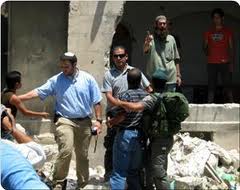 Left: Guarded Israeli settlers seize new house in Jerusalem from Palenstinians.
Left: Guarded Israeli settlers seize new house in Jerusalem from Palenstinians.
Joining these settlers at their commemoration service on behalf of this enterprise is Nobel Peace Prize winner Elie Wiesel. Not only that, he’s the chair of Elad’s Advisory Board. Also attending the commemoration as friends of Elad were two former Israeli intelligence chiefs, Shabtai Shavit and Amos Yadlin, and a number of prominent officials.
To Wiesel, anyone who is a friend of Israel is a friend of his.
Another friend is John Hagee. In 2009, after reportedly losing a large sum of money he had invested with Bernie Madoff, Wiesel made a cool half million for one speech to Hagee’s Christians United for Israel (CUFI) benefit. During the celebration of the Feast of the Tabernacles at Hagee’s San Antonio TX mega-church, Wiesel was keynote speaker on the “Night to Honor Israel.” CUFI gave $9 million to Israel charities that night, of which $500,000 went to Wiesel’s Foundation for Humanity.
Wiesel has also joined Alan Dershowitz in sponsoring a Jewish anti-Iran group. In an interview by John Hagee, Wiesel said of Iran’s leader Mahmoud Ahmadinejad:
“… this man is a disgrace to humanity. […] This man is the No. 1 Holocaust denier in the world. This man publicly, repeatedly says that he needs, that he wants nuclear weapons to wipe off the Earth one Jewish state. This man should be arrested and brought to Hague to face the international tribunal and charged with the incitement of crimes against humanity. He does not deserve to be a president of any country. He should never be accepted anywhere as a guest, neither to New York nor to Paris, nor anywhere. He must be a persona non grata all over the world.”
Clearly, Wiesel thinks nations should not be allowed to choose their own leaders. They must be vetted by Israel. If they are not friends of Israel, they should be accused of incitement of crimes against humanity and shunned everywhere. He called the Goldstone Report a “crime against the Jewish people.”
Criticism of Elie Wiesel from the liberal left is growing. However, they tend to put it in this way:
“I’m sorry to say that Wiesel has fallen from the high pedestal on which Jews have placed him. He no longer wears a crown of moral righteousness.”
What they don’t understand is that he never was righteous, and neither are the Jews who call themselves survivors necessarily righteous. Survivors of what? They survived a turbulent period in history the same way millions of others did–by luck, by opportunism, and sometimes by devious means. The Jewish deportations were given the name “The Holocaust” by Wiesel himself, so he says. Meaning, they named their own event to suit themselves. Every Jew who lived within an area of German occupation from 1933-1945, or who felt compelled for whatever reason to move from there to a non-German occupied area is considered a ‘Holocaust survivor.’
Wiesel is an unabashed supporter of Israel. Like John Hagee and Alan Dershowitz, he excuses the excesses of the State of Israel on religious grounds … the religion of Zionism and the religion of the Holocaust.
It’s time for left, liberal Jews to do more than take up the cause of Palestine by criticizing Israel’s violence and brutality. They need to look at the whole, rotten story of King Wiesel – and the rest of the ‘survivors’ he symbolically represents. They can begin that unpleasant task right here at Elie Wiesel Cons The World.
Another photo of young Elie Wiesel that is not Elie Wiesel
Written on October 1, 2011 at 6:25 am, by Carolyn
by Carolyn Yeager
Discovered! The newspaper photograph from which Hilda Wiesel recognized her brother Elie at the OSE home near Paris. (Might take some time to download.)
At the end of her video-taped Shoah Foundation testimony in 1995 (the same year Wiesel’s memoir All Rivers Run to the Sea came out), Hilda Wiesel Kudler shows some family pictures: her mother, her father, her sister and brother, and lastly the one above.
Hilda says (translated from French): With the cap, that’s him. My brother with the cap. That is this picture that I saw in Paris and thanks to this picture we met. I was for several months in Paris, as he was too; and we didn’t know we were both alive—and thanks to this picture we met.
Hilda may have been on the look-out for her brother when she saw this photo and thought or hoped it might be him. By contacting that OSE home that was mentioned in the story, and asking about Eliezer Wiesel, they located him there and the brother and sister were reunited. A heartwarming story, but it’s clear to me that the boy in this picture is not Elie Wiesel. Compare the known Elie in the picture below taken at the same time.
Below is an enlargement of the chess-playing boy. (click twice)
This boy is what you’d call gawky, which young Elie was not as we know from other pictures of him at Ambloy during this same few months of the second half of 1945. This boy’s chin is too long and his ear appears to curve outward away from his head. The nose is short. Both boys faces seem to me to have been retouched in a crude fashion to define the features, especially the eyes. The chess player’s arms and legs are unusually long—compare them to the other boy—which is not true of Wiesel in all the pictures of him we have seen. This suggests he is going to be a tall person, while Elie Wiesel has never been more than 5’9” tall. Clearly this lad is a young adolescent, still growing at an uneven rate. If you, dear reader, can believe this is Wiesel, let me hear from you and give me your reasons.
Another point is that Wiesel always wore a beret, and I don’t think he would be caught dead in a cap like that. Nor in those striped pants. He took himself too seriously to be going about in such garb.
Yet, Elie writes in All Rivers that he remembers the day when two journalists took a picture of him when he was playing chess with another boy If that is indeed the truth, the picture taken of Wiesel was not the picture published in the newspaper that Hilda Wiesel saw. As I wrote in Elie Wiesel and the Mossad:
Wiesel says he “rededicated” himself to his sacred studies, and in between played chess. One day:
…a couple of strangers wanted to take pictures as we played. One of them asked some questions in bad German; I answered in good Yiddish. Someone said they were journalists, but I had never met a journalist before; they were of no interest to me, and I didn’t see why I should interest them. (All Rivers, p 113)
Here Wiesel’s orthodox Jewish “apartness” reveals itself. Those in the non-Jewish world were of no interest, unless and until they were needed for some purpose. But the question at hand is whether Hilda still believes this is a photo of her brother, or whether she is in on the creation of the Wiesel family legend. Elie must know it is not him, but he seems to attempt to affirm it is when he writes in All Rivers that “they were of no interest to me”—aligning with the boy in the photograph who does in fact look disinterested.
If Elie Wiesel were honest, he would declare the picture his sister saw was NOT of him playing chess. Would that take too much away from his sister’s feeling of pride or importance that she happened to recognize him in a newspaper? When feelings are more important than truth, the actual truth can be shape-shifted in any number of ways.
This is the way of Jews—not only about their imagined holocaust but concerning their affairs in general—that the rest of us don’t quite understand and should not be forced to go along with. If they want to lie to themselves, fine, but don’t lie to us. We should call them on it. That’s what I think.
Q & A with Elie Wiesel
Written on September 28, 2011 at 7:56 am, by Carolyn
With Commentary by Carolyn Yeager
This Q & A was presented in the Post and Courier newspaper on September 18 as a question & answer session in connection with Elie Wiesel’s speech at the College of Charleston (South Carolina) on Sunday, Sept. 25.
I have added some comments and questions that I would have liked to ask Mr. Wiesel had I been allowed to be present. Of course, this was a very controlled event, if it were not, in fact, private, one week before the speech. The main interest here is how Wiesel skirts around all questions and gives the same pat answers that he has been giving for years. He has rehearsed what he will say and does not go beyond his rehearsed answers; thus his answers never change and often strike an aberrant note, as if not directly relating to the question. ~cy
The first picture accompanying this news story is the famous one that is permanently associated with Wiesel wherever he goes.
The caption tells us that Wiesel is in the picture, but we, the followers of this blog, know that he is not and that a Gigantic Fraud has been carried out concerning this picture, by powerful forces such as the New York Times, and by Wiesel himself.
Q: In your book “Night,” you describe the ardent faith you practiced as a child and address the dilemma of a compassionate God, making it clear that because of the Holocaust and what you witnessed during your ordeal, you became a skeptic. Are you still asking questions? What is the nature of your faith or nonfaith today?
A: First question, yes, I continue asking questions. I belong to the Talmud tradition. The Talmudic tradition actually emphasizes the question, much more than the answer. Answers come and go, the questions are eternal. When it comes to the question of faith, of course, … profound or painful. So what I say to myself is, “Of course I believe in God.” I believe in God because my father and my grandfather and his and so forth, they all believed, and (down) the line — I hope I’m not the last. … But my faith is a wounded faith.
Comment: Wiesel is proud to be Talmudic. In his tradition, answers are not expected. Perhaps answers are not even missed, for Talmudic Jews take pride and pleasure in endlessly discussing what is God among themselves. They determine God; it is not God who informs them. Wiesel says he continues to profess belief in God because he wants to honor his ancestors. It is a Jewish tradition.
Q: And what about the concept of justice? Is it possible to reconcile it with the abomination that was the Holocaust?
A: To me, this is the question of all questions. On many levels, I don’t understand God, which I cannot. We have a very, very great sage called Rabbi Eliezer HaKalir. He was a great, great thinker and a poet, too. And he said, “If I knew God I would be God.” So nothing concerning, really, the definitive God, the Almighty, Just, the King of the Universe is a question. I don’t know how it’s possible He knew and yet he is silent. So the silence of God troubles me. But it doesn’t stop there. The silence of the world’s leaders also troubles me.
Comment: The King of the Universe, says Wiesel, is silent about the Holocaust. Could it be because it is untrue and their God doesn’t or can’t acknowledge what is false and has no reality? In any case, Wiesel would rather focus on the world and its leadership.
Q: There’s sacred justice, but there’s also human justice.
A: Yes. Human justice. Exactly.
The next picture shows President Barack Obama shaking hands with Elie Wiesel, who specifically invited the U.S. president to visit the former Buchenwald camp during his trip to Germany in June 2009. Wiesel has great influence as the most famous survior of Buchenwald … but wait! He wasn’t at Buchenwald. There are no records of his being there and he is not in the famous photograph above. What kind of trick is being played on the unsuspecting President Obama?
Q. And what about that? Humans are so fallible, as we know, and their justice is imperfect. Do you still think that (human) justice could ever match the depth of the injustice of the Holocaust itself?
A: It comes to define justice. Justice with a capital J — absolute justice — is one question. But the justice which has, — how to say? — betrayed, perverted human beings, that’s another question.
Comment: This answer doesn’t answer anything. Instead, it repeats the question–a typical Wieselian response.
Another iconic photo chosen for this story is this one also taken at Buchenwald in 2009. It shows Obama and German Chancellor Angela Merkel walking with Wiesel (on the right), who is “showing them around.” I believe this is his very first visit there. But then, that’s no doubt true for all of them.
Q: Has life for you continued to be a long “night”? If so, what has kept you going? What, if anything, gives you joy?
A: Joy. … I see children, I have joy. I have my grandchildren, I have joy. On the other hand, I remember that we lost almost 2 million children. So the joy is not a perfect joy anymore.
Comment: Apart from the fact that 2 million children were not lost, Wiesel is a millionaire, lives in one of the highest priced locations in the world, is listened to by rulers, presidents and celebrities; has hundreds of people to do his bidding. The public treats him with reverence. His beloved State of Israel has become a great power. But I guess we’re to believe he is really suffering.
Q: Has there been any change, any little glimmer of light that managed to penetrate the “night”?
A: The answer is yes, it must be. It must. I think it was (Albert) Camus who said when there is no happiness, you must create happiness. That goes for joy, that goes for peace, that goes for all the good things in life. To say that night has vanished, no, it’s not, it’s still there. But paradoxically, other things came afterwards, and they, too, are as real. In other words, I would still say night is long and infinite, but I’m not alone in this world.
Comment: Time for the violins to start playing in the background.
Q: And in a way, perhaps, your writing itself, all the books, has helped to create some semblance of happiness for you?
A: Only if other people are happy and feel victorious over sadness. My happiness must be a result of theirs.
Comment:The violins are still playing.
Q: The Holocaust surely was an aberration, an example of Fascism run amok. But Fascism has a tendency to run amok, as you repeatedly have pointed out. You have condemned genocides and reminded the world that it must remain vigilant. How do you categorize the Holocaust? Was it unique in its nature, or only its scale?
A: No, I think it was unique; therefore, it must remain unique in memory. Once you say that it’s not, it opens history again to other mass murder. History has proven that it can and, therefore, it may continue.
Comment: Take notice! Wiesel is making it clear: the Jewish Holocaust was unique! His reasoning (?) is that if it were not, new genocides can happen. The Holocaust, by being unique, closes history to more mass murder. (This is perilously close to saying the Jews died so that others would not — an aspect of their hidden agenda to replace Christ with The Jew.) But he follows by saying it can, and may, continue. As he said at the beginning, there are no answers … not from God and not from him.
Q: You have long been a supporter of Israel, and were once invited to consider public office there.
A: (Laughing) I was offered to be a president. I was under pressure in the first few weeks, and, you know how it is, the more I said no, the harsher the pressure grew.
Comment: He has a close relationship to all top Israeli politicians, from at least 1950 on.
Q: So what made you decide to stay in the United States?
A: I came here in 1956. I came as a stateless person. Can you imagine? You cannot, because you were born here probably. … And here I came, I was accepted by the United States as an American citizen. And I had my passport all the time with me because I never had another passport in my life. So I owe this country quite a lot. I love this country.
Comment: This is an insincere answer. He could have become a citizen in any state, certainly in France even when he was underage. He didn’t want to. He wanted to be in the most powerful country, the one the Jews of Israel planned to control. This is why he came to the U.S. and devoted himself to projects like bringing into existence the United States Holocaust Memorial Museum, a huge victory for Jews.
Q: Do you ever worry about the ways in which the Holocaust has defined Jewish identity since the war?
A: Well, I know I read about it. Some people believe this is exaggerated — we shouldn’t do that. I don’t like to turn it into an object for discussion. … What every person does or thinks with regards to (an event), I don’t want to put myself in their soul-searching. I think memory is what defines a human being and society. If you betray memory, you betray yourself and all those who believe in it.
Comment: He doesn’t answer the question. In truth, the ‘Holocaust’ has defined not just Jewish, but Anglo-American and European identity in ever-increasing strength since 1945. It is non-Jews who should be very worried about how the Big H has defined our identity, which is why Wiesel avoids the subject.
Q: When it comes to Jewish identity, how important is Israel? And what do you think should be done to resolve the conflict there?
A: I’m optimistic. … My foundation has created many things. My foundation is the one that brought together the prime minister of Israel (Ehud Olmert) and (Palestinian Authority) President (Mahmoud) Abbas. (Note: The historic first meeting of Olmert and Abbas took place at the Elie Wiesel Foundation’s second annual Conference of Nobel Laureates in Petra, Jordan, on June 22, 2006.) For the first time, they met under our auspices, and they met, they fell into each other’s arms with tears in their eyes. I turned to my wife, I said, “Look.” This is the best event that I witnessed in many, many years. Which means it can be done, therefore, it will be done, my feeling is within a year or two.
Comment: How evasive is that? He brings up something that occurred in 2006 – 5 years ago! This is more avoidance of facing the real crisis that Jewish Israel has brought about by its constant theft in the name of establishing an ‘identity’ for itself.
Was Lazar Wiesel a relative of Elie Wiesel?
Written on September 23, 2011 at 12:58 pm, by Carolyn
By Carolyn Yeager
The real inmate at Buchenwald, Lazar Wiesel, 31 years old in 1944, was the son of Szalamo and Serena Feig Wiesel of Sighet.
We present the question of why the personal information on Lazar Wiesel is so close, but still far from exact, to that of Elie Wiesel. Can we believe, as Prof. Kenneth Waltzer would have it, that these were errors in taking down the information on Elie, and Lazar is really Elie? No, we can’t because the nature of the differences cannot be simple errors. Lazar had a brother Abram with him in the camps; the 44 year-old Abram (in 1944) cannot be turned into Elie’s father. And he certainly can’t be turned into Lazar’s father as only 13 years separated them. But it is very possible that the two families were related and that a part of Elie’s immediate family escaped the deportation altogether. Many so-called Hungarian Jews did – many more than are officially acknowledged. Keeping this in mind, I will examine the family names and see what they tell us.
Lazar Wiesel’s Buchenwald File Card (below) records Lazar’s father, Szalamo (equates to Sholomo), as being interned at Buchenwald.1 But more striking, Lazar’s mother, Serena Wiesel nee Feig, is listed on this card as being interned at KL Auschwitz. (As we know, Elie’s story is that upon arrival he saw his mother and sister moving away with the women and never saw them again. The idea they went to a gas chamber is pure speculation copied from other books.)
CLICK ON CARD FOR AN ENLARGED VIEW. Buchenwald Registration file card for Lazar Wiesel, birth date Sept, 4, 1913, arriving on Jan. 26, 1945 from KL Auschwitz.
Elie Wiesel’s parents are known to be Shlomo and Sara (or Sura) Wiesel, nee Feig.
In Jewish Orthodoxy (the Wiesel’s were members of the Hasidim sect) and in Eastern Europe generally, certain family names were repeatedly used—recycled if you will. This is certainly the case in the Wiesel family with the names Eliezer, Elisha, Shlomo and Sara, and probably some others we don’t know about.
It’s no surprise that we find the name of the founder of Hasidic Judaism to be Rabbi Yisroel ben Eliezer, and that he was born to Eliezer and Sara in Okopy, a small village that over the centuries has been part of Poland, Russia, and now Ukraine.
Wiesel was named after his grandfather Eliezer. His other grandfather on the maternal side is Dovid Feig.
Looking for genealogical information on Elie Wiesel is a disappointing affair—so little can be found. For such a famous person, a Nobel Peace Prize Laureate, to have his family history wiped away, hidden or not known is strange indeed. How to explain it when Hasidic family ancestry is traditionally honored and held in high esteem. It must be purposely hidden. The Jews talk about Adolf Hitler hiding his ancestry. Not at all. Hitler’s complete and accurate genealogy is available on the Internet, but Wiesel’s is not. How do we figure that?
The #1 site on Google Search for Wiesel’s genealogy is Geni which has only very limited information. There is nothing additional to be found on Wikipedia. I have filled in the gaps with two pages of testimony from Yad Vashem’s online database—one for his father that Wiesel filled out himself, and one for his father’s mother, Nisel, that was filled out by her grandson Eliezer Shlomovitz, who lives in Los Angeles, CA. This is all I could uncover and I do not guarantee the correctness of any of it.
Father: Shlomo Elisha Wiesel
- Parents: Eliezer Vizel and Nisel Vizel nee Bash. This grandfather Eliezer died serving on the side of the Austro-Hungarian Empire in WWI.
- Nisel was born in Chust (or Hust, not far from Sighet), later Ruthenian-Czechoslovakia , in 1880 to Moshe and Yehudit Bash, according to a Yad Vashem death report (mentioned above).
- Shlomo is said by several sources to have been born in 1894, but I think this is deduced from the book “Night” where he is said to have been age 50 in 1944. If this were correct, it would make Shlomo’s mother’s age 14 when he was born — highly unlikely. Elie Wiesel never gives his father’s or mother’s birth dates though it’s not like he doesn’t know.
- Wiesel writes in his memoir All Rivers Run to the Sea that he met his father’s brother Samuel in New York, but he has never written about his cousin Eliezer Shlomovitz in Los Angeles.
Mother: Sara Feig Wiesel
- Parents: Dodye (Dovid) Feig; no mother given
- Wiesel highly praises this grandfather in All Rivers and writes, “… in 1944 my parents invited him and his wife to live with us.” His wife, not ‘my grandmother.’ That is the only mention of ‘her.’ Seems clear she was not Elie’s grandmother, but a new wife. In any case, grandfather Feig declined and went to stay with his sons.
- Elie writes in All Rivers: “I had four uncles on my mother’s side: Chaim-Mordechai, Ezra, Israel and Moshe-Itzik
- He met an ‘Uncle’ Morris in New York.
From the little we have available, we can see certain names repeating. Elie Wiesel gave his son his father’s name, Shlomo Elisha. He himself was named after his paternal grandfather Eliezer. A cousin, another grandson of his paternal grandmother, is also named Eliezer. This cousin’s last name is Shlomovitz. From this we can begin to ascertain that Eliezer, Shlomo, Elisha and Sara are “family names” within the extended Wiesel family, along with being Hasidic names.
Two marriages between the Wiesel’s and the Feig’s
Looking back at the Lazar (from Eliezer) Wiesel who was at Buchenwald, we see another marriage between the Wiesel’s and the Feig’s. We see the same names: father is Szalamo (Shlomo); mother is Serena Feig. Lazar is 15 years older than Elie and his brother Abram is 28 years older, and they are from the same city, Sighet. It seems pretty clear to me that these are two branches of the family tree.
Matchmaker, Matchmaker, make me a match!
 Orthodox men and women usually meet through matchmakers in a process called a shidduch. A matchmaker’s services are necessary because of the constant intermarriage going on within the closely knit Orthodox communities. A matchmaker (shadchan) knew of the relations between those in the community, or could find them out, and could therefore prevent or warn against marriages between a couple who were too genetically similar. This role is not mentioned on Wikipedia and other Jewish sites, but it’s the most important one. In Night, Wiesel wrote that in 1943 his mother “was beginning to think it was high time to find an appropriate match for Hilda” who was already 21 years of age.2
Orthodox men and women usually meet through matchmakers in a process called a shidduch. A matchmaker’s services are necessary because of the constant intermarriage going on within the closely knit Orthodox communities. A matchmaker (shadchan) knew of the relations between those in the community, or could find them out, and could therefore prevent or warn against marriages between a couple who were too genetically similar. This role is not mentioned on Wikipedia and other Jewish sites, but it’s the most important one. In Night, Wiesel wrote that in 1943 his mother “was beginning to think it was high time to find an appropriate match for Hilda” who was already 21 years of age.2
The two families, Feig and Wiesel, may have been recognized as having diverse enough genetic relationship to one another to make for viable marriages. Perhaps there was a history of successful unions between the two family lines. In any case, it can explain the similarity in personal information between the older and younger Wiesel, and also the temptation to claim the one to be the other. The family members can be trusted to remain silent about it.
This last part is speculation, but one thing we notice is that Elie Wiesel does not want us to know who or where are the members of his family, and even more, he doesn’t want any of his family members to talk to us, the general public. We are not to know anything but the simplistic legend that he and his supporters and defenders have created for our consumption.
An interesting side-note: I just discovered a book From Generation to Generation by Arthur Kurzweil, published in 2004, which features on the cover “Foreword by Elie Wiesel.” This foreword turns out to be only one page long, much shorter than the Acknowledgements even, and consists of a few vague words about the mystical aspect of names. What is interesting is that the book is 400 pages of “how to research your Jewish genealogy.” If Wiesel has researched his own, he certainly is not publishing it. Wiesel gives himself the prerogative of remaining a very private man, while working hard to become a highly public name. Jewish chutzpah at work.~
Endnotes:
1. Myklos Gruener never mentioned a father for Lazar and Abram, only his own father.
2. Elie Wiesel, Night, Hill and Wang, 2006 (original copyright 1958), p. 8

